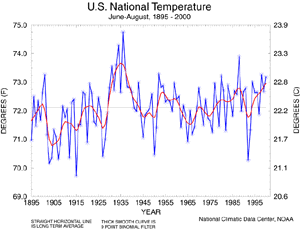 |

Contents of This Report:

 National Temperature - June-August
National Temperature - June-August
 larger image |
The summer, June-August 2000, monthly mean temperature averaged across the contiguous United States, based on data from the U.S. Historical Climate Network (USHCN) and preliminary data from the Climate Division Database, ranked as the 11th warmest summer season since national records began in 1895. The preliminary nationally averaged temperature for the season was 73.2° F, 1.1° F above the long-term mean. Six of the last seven summer seasons have averaged above the long term mean. The actual summer season temperature values from 1895 through 2000 are available. |
| The map to the right, based on approximately 250 airport stations, shows departures from the 1961-1990 normal temperatures for June-August 2000. In general, the western Great Lakes, Ohio Valley, and areas from the mid-Atlantic northward, were cooler than normal. Areas from the central Gulf Coast to the Southwest as well as the western high Plains and the Rockies were warmer than normal. The Pacific coast was near to slightly below normal. The Alaskan interior was cooler than normal while most of the rest of the state and Hawaii averaged near normal. | 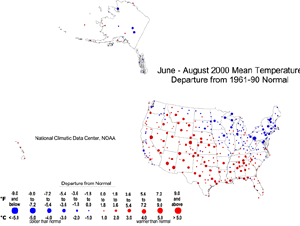 larger image |
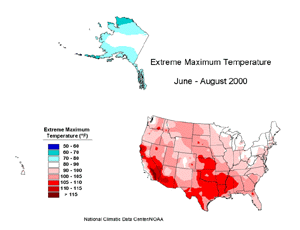 larger image |
Extreme maximum temperatures during summer 2000 exceeded 115° F through parts of southern California. Temperatures exceeded 90° F elsewhere throughout the country except the highest points in the Rockies, along the immediate Pacific coast of central and southern California and northern Washington. Temperatures also failed to exceed 90° F from the upper western Great Lakes through the eastern Ohio Valley, central Appalachians and the interior mid-Atlantic and Northeast. Approximately 700 ASOS stations were used in this analysis. |
| The number of days with high temperatures in excess of 90° F exceeded the normal number of days of greater than 90° F for June-August 2000 over most of the Rocky Mountain region and western High Plains as well as from southeastern Texas to western South Carolina, south to central Florida. Within this area, the departure exceeded the normal by at least 20 days over the panhandle of Nebraska, the central Gulf Coast of Texas, extreme southern Louisiana, and portions of Alabama, Georgia, and the upstate of South Carolina. | 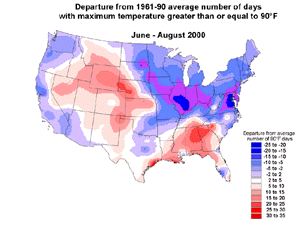 larger image |
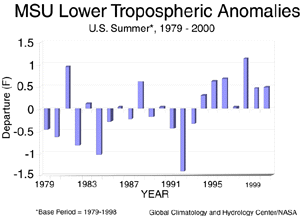 larger image |
Data collected by NOAA's TIROS-N polar-orbiting satellites and adjusted for time-dependent biases by NASA and the Global Hydrology and Climate Center at the University of Alabama in Huntsville show warmer than average temperatures in the lower half of the atmosphere (lowest 8 km or 26,200 feet of the atmosphere) over the U.S. The average lower tropospheric temperature over the continental U.S. during the June-August 2000 period was 0.50° F above the 1979-1998 long-term mean. |

 National Precipitation - June-August
National Precipitation - June-August
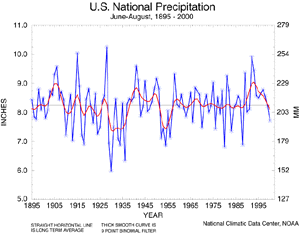 larger image |
Based upon preliminary precipitation data, summer 2000 ranked as the 24th driest such season since national records began in 1895. About 19% of the country was much drier than normal while about six percent of the country was much wetter than normal. Summer 2000 was the first summer since 1991 in which nationally averaged precipitation was below normal. |
| The preliminary national standardized precipitation index ranked summer 2000 as the 15th driest such season since national records began in 1895. | 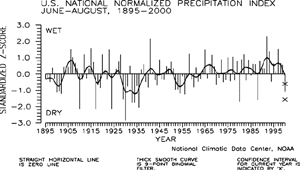 larger image |
| The map to the right, based on approximately 250 airport stations, shows summer 2000 total precipitation as a departure from 1961-1990 station normals. Above-normal precipitation can be found in the Aleutians, extreme north, and southeastern Alaska, while most of the other Alaskan stations were near normal. The Hawaiian stations averaged slightly wetter than normal. On the mainland U.S., stations were predominantly wetter than normal from the western and central Great Lakes region, parts of the mid-Mississippi Valley, and portions of the mid-Atlantic and lower New England. Stations were predominantly drier than normal from the Pacific Northwest, through the Rockies and western high Plains, the Southwest, and from Texas, eastward to South Carolina and south through Florida. | 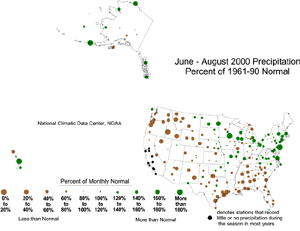 larger image |


Current data are based on preliminary reports from River Forecast Center stations and First and Second Order airport stations obtained from the National Weather Service (NWS) Climate Prediction Center and real time Global Telecommunications System (GTS) monthly CLIMAT summaries. THE CURRENT DATA SHOULD BE USED WITH CAUTION. These preliminary data are useful for estimating how current anomalies compare to the historical record, however the actual values and rankings for the current year may change as the final data arrive at NCDC and are processed.
The following NCDC datasets are used for the historical U.S. data: the climate division drought database (TD-9640), and the hurricane datasets (TD-9636 and TD-9697). It should be noted that the climate division drought database consists of monthly data for 344 climate divisions in the contiguous United States. These divisional values are calculated from the 6000+ station Cooperative Observer network.
 NOAA's National Centers for Environmental Information
NOAA's National Centers for Environmental Information